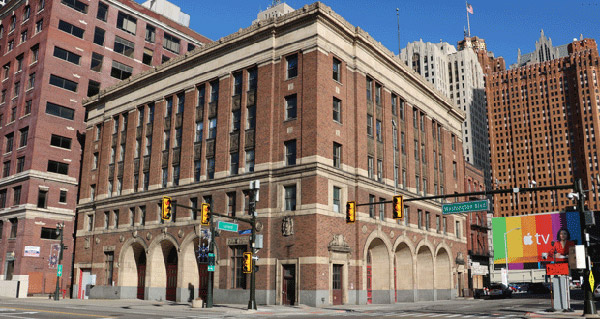
Converting historic buildings into hotels is a strategy that can economically benefit enterprising hotel owners, operators, and investors. A well-executed historic renovation project combines the most sophisticated aesthetic and architectural elements of an antique property with the contemporary conveniences of a modern hotel. The result is a hospitality holy grail: an appealing hotel property with a memorable and defining sense of place.
In that context, it’s not difficult to understand the appeal of this trend. It’s particularly prevalent in cities like Detroit, where a ready supply of architecturally significant and historically resonant structures are unused or underutilized. This trend is also taking place in urban markets across the country–from Los Angeles to Chicago and New York (where Brooklyn is a particularly active market for historic hotel renovations). Growing market demand for smaller, boutique hotels and independent properties with unique character and local charm is only fueling this real estate movement.
The challenges of repurposing and renovating an antique property to make it fit modern requirements can seem daunting, but the reward is often worth the risks. Selecting the right construction partner is essential to help navigate everything from significant design and construction issues, to unpredictable costs and unique considerations about how to affordably and efficiently preserve the artistry and character of the original space.
Costs and considerations
Money is, of course, an inescapable and overriding concern when renovating a historic structure. Some of the primary issues that can frustrate developers and bust budgets include:
Space constraints
When you are dealing with an existing building, the size and contours of the space you work with can be dictated by the existing historical elements. You may have to design around columns or unusual corridors. Working within those parameters often influences design decisions. The net result may be a wide range of non-standard room sizes and shapes, which adds to the complexity of the rehab because the location of bathrooms, kitchenettes, and bedrooms will differ based on the floorplan. Having a collection of rooms of various sizes and shapes often appeals to repeat visitors who value a new experience with each visit.
Infrastructure upgrades
Upgrading mechanical, electrical, and plumbing (MEP) systems such as new HVAC ductwork, wiring, and water supply piping can be a significant challenge and more of an expense. When repurposing a historic building, existing MEP systems may no longer be usable due to its location or new building codes. Though it’s a complex process that involves significant planning and investing in pre-construction efforts, replacing existing MEP systems could save significant dollars for the hotel’s operations.
Structural concerns
Making structural changes to an antique building can be enormously complicated and potentially expensive. The lack of complete drawings and information regarding the structure can lead to unanticipated delays and costs. When buildings have been vacant for long periods of time, you almost always see varying levels of deterioration that must be repaired or addressed. It is important that your construction team proactively collaborates with a historic preservation expert to evaluate the building and develop a plan to ensure no architectural details are demolished during this phase of construction.
Obstacles and opportunities
Hotel developers who have mastered the art of renovating antique structures have stories of surprising discoveries: from an exterior wall that turns out to be a pile of stacked bricks with no cohesive structural integrity, to wooden window frames that double as headers and would bring down the entire wall if you tried to replace the windows. The unknowns are always the biggest issue going into a historic renovation. That unpredictability makes these projects inherently riskier and creates a set of circumstances where developers and investors have less control over the outcome of the project. It also translates to the bottom line: a typical new hotel construction may have cost contingencies of 3-7 percent, but that figure is more commonly in the 12-20 percent range in a complex historical renovation project.
The flip side of that uncertainty is that sometimes you can uncover hidden elements that can be incorporated into the design to save money and bring out the authenticity of the space. Perhaps you discover gorgeous terra cotta tiling details that were plastered over, hidden flooring or other architectural details that can be displayed in a feature wall or common area. When those features are successfully preserved, it can have a dramatic and appealing impact on the artistry, aesthetic and experiential impact of the finished space. So many architectural elements—stone, limestone and dentils—help bring out the unique character of these hotels, providing patrons with a unique and memorable experience.
Understanding which details to preserve (and how best to preserve them) makes historic hotel renovations much more of an art than a science. Ultimately, it’s a balancing act, retaining the sense of history and defining character of the building, while simultaneously converting it to be functional, safe, and comfortable–complete with modern amenities. When done well, the result can be a hotel property that is visually, architecturally and experientially unique: a valuable and profitable addition to any hospitality portfolio.


![[Intelligent Hotel Lock] YGS-9901B](https://zeimg.jiagle.com/media/2016/11/24/6037221479970596.jpg!180)




Service Hotline
Work Time:Mon-Fri 9:00-18:00
UTC+8

Sinoexpo Digital Platform
Copyright 2006-2025 Shanghai Sinoexpo Informa Markets International Exhibition Co., Ltd. All rights reserved
沪ICP备05034851号-77
 沪公网安备 31010402000543号
沪公网安备 31010402000543号